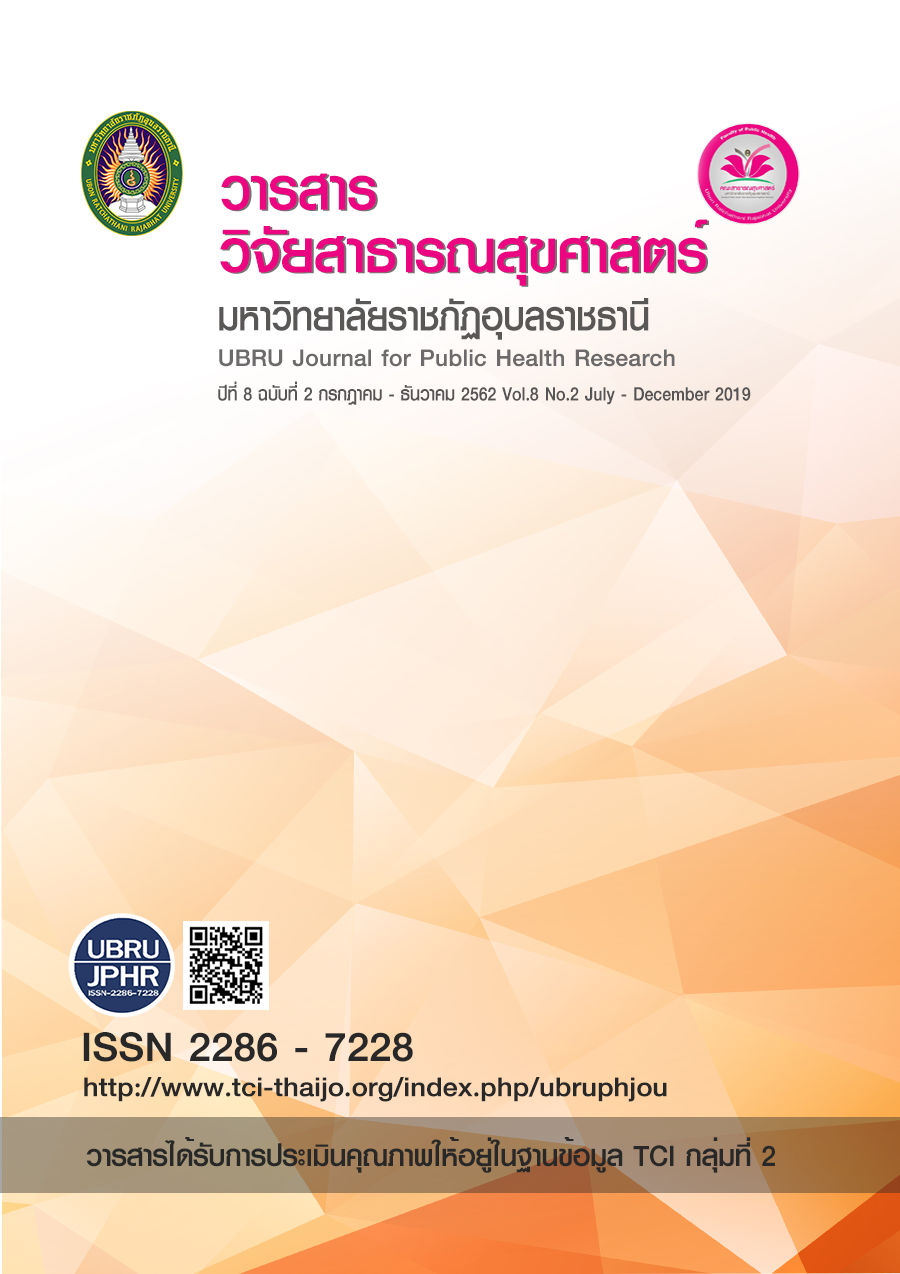ผลการจัดการเรียนรู้แบบสืบเสาะหาความรู้ 5 ขั้น (5E) ในวิชา กายวิภาคศาสตร์และสรีรวิทยามนุษย์ 2 ต่อความสามารถด้าน การคิดวิเคราะห์และความพึงพอใจของนิสิตพยาบาล
คำสำคัญ:
การเรียนรู้สืบเสาะหาความรู้, การคิดวิเคราะห์, นิสิตพยาบาลบทคัดย่อ
การวิจัยครั้งนี้เป็นการวิจัยกึ่งทดลอง มีวัตถุประสงค์เพื่อศึกษา ความสามารถด้านการคิดวิเคราะห์ โดยใช้รูปแบบการจัดการเรียนรู้แบบสืบเสาะหาความรู้ 5 ขั้น (5E) ในวิชากายวิภาคศาสตร์และสรีรวิทยามนุษย์ 2 และ ความพึงพอใจของนิสิตพยาบาล ที่เรียนโดยใช้รูปแบบการเรียนรู้แบบสืบเสาะหาความรู้ 5 ขั้น (5E) กลุ่มตัวอย่างเป็นนิสิตพยาบาลชั้นปีที่ 1 มหาวิทยาลัยเวสเทิร์น บุรีรัมย์ ภาคการศึกษาที่ 2/2560 จำนวน 30 คน ใช้วิธีสุ่มอย่างง่าย เครื่องมือวิจัยประกอบด้วย 1) แผนการจัดการเรียนรู้ที่มีรูปแบบสืบเสาะหาความรู้ 5 ขั้น (5E) วิชากายวิภาคศาสตร์และสรีรวิทยามนุษย์ 2 2) แบบทดสอบวัดความสามารถด้านการคิดวิเคราะห์ ความเชื่อมั่นเท่ากับ 0.72 และ 3) แบบวัความพึงพอใจของนิสิตพยาบาลที่มีต่อการจัดการเรียนรู้โดยใช้รูปแบบสืบเสาะหาความรู้ 5 ขั้น (5E) วิเคราะห์ข้อมูลโดยหาค่าเฉลี่ย ส่วนเบี่ยงเบนมาตรฐานและเปรียบเทียบค่าเฉลี่ยโดยการทดสอบค่าที (paired t-test)
ผลการวิจัยพบว่า กลุ่มตัวอย่างมีความสามารถด้านการคิดวิเคราะห์หลังเรียนสูงกว่าก่อนเรียนอย่างมีนัยสำคัญทางสถิติที่ระดับ .01 และความพึงพอใจต่อการจัดการเรียนรู้โดยใช้รูปแบบสืบเสาะหาความรู้ 5 ขั้น (5E) อยู่ในระดับมากที่สุด (4.61, S.D.=0.31)
การจัดการเรียนการสอนแบบสืบเสาะหาความรู้ ในวิชากายวิภาคศาสตร์และสรีรวิทยามนุษย์ 2 ทำให้มีผลสัมฤทธิ์การเรียนเพิ่มขึ้น ผู้บริหารควรสนับสนุนให้ครูนำรูปแบบดังกล่าวไปใช้
เอกสารอ้างอิง
กรรณิการ์ กวางคีรี. (2554). การพัฒนาทักษะการคิดวิเคราะห์และความเข้าใจที่คงทน ของนักเรียนชั้นมัธยมศึกษาปีที่ 1 ที่จัดการเรียนรู้แบบสืบเสาะหาความรู้. วิทยานิพนธ์ศึกษาศาสตรมหาบันฑิต สาขาวิชาหลักสูตรและการนิเทศ มหาวิทยาลัยศิลปากร.
กระทรวงศึกษาธิการ. (2560). มาตรฐานคุณวุฒิระดับปริญญาตรี สาขาพยาบาลศาสตร์ พ.ศ. 2560. [ออนไลน์]. ได้จาก http://www.mua.go.th/. [สืบค้นเมื่อ 7 มกราคม 2562]
ชัชวาล วงศ์สารี. (2558). การสอนบนคลินิกในรายวิชาปฏิบัติการพยาบาลผู้ใหญ่สำหรับนิสิต Generation Z. วารสารวิทยาลัยพยาบาลบรมราชชนนี กรุงเทพ. 31(2),130-140.
ดวงใจ บุญประคอง. (2549). การพัฒนาผลการเรียนรู้เรื่องการดำรงพันธุ์ของสิ่งมีชีวิตของนักเรียนชั้นประถมศึกษาปีที่ 5 ที่จัดการเรียนรู้แบบสืบเสาะหาความรู้. วิทยานิพนธ์ศึกษาศาสตรมหาบัณฑิต สาขาวิชาหลักสูตรและการนิเทศ มหาวิทยาลัยศิลปากร.
พิชญะ กันธิยะ. (2559). การพัฒนาทักษะการคิดวิเคราะห์ โดยใช้การจัดการเรียนรู้แบบบันได 5 ขั้น วิชาวิทยาศาสตร์ ของนักเรียนชั้นมัธยมศึกษาตอนต้น. วิทยานิพนธ์ครุศาสตรมหาบัณฑิต สาขาวิชาหลักสูตรและการสอน มหาวิทยาลัยราชภัฏเชียงใหม่.
วิจารณ์ พานิช. (2555). การเรียนรู้ในศตวรรษที่ 21. [ออนไลน์]. ได้จาก http://www.qlf.or.th/. [สืบค้นเมื่อ 30 กันยายน 2560]
ศศิวิมล สนิทบุญ. (2559). ผลการจัดการเรียนรู้แบบสืบเสาะหาความรู้ 5 ขั้น (5 E) ร่วมกับการใช้คำถามเชิงวิเคราะห์ ที่มีต่อมโนทัศน์และการคิดวิเคราะห์ทางวิทยาศาสตร์ ของนักเรียนชั้นมัธยมศึกษาปีที่ 6 เรื่อง ฟิสิกส์อะตอม. วิทยานิพนธ์การศึกษามหาบัณฑิต สาขาวิชาการสอนวิทยาศาสตร์ มหาวิทยาลัยบูรพา.
สภาการพยาบาล. (2555). สมรรถนะหลักของผู้ประกอบวิชาชีพการพยาบาลและผดุงครรภ์. [ออนไลน์]. ได้จาก http://110.164.68.234/nursefiles/ethics04.pdf. [สืบค้นเมื่อ 30 กันยายน 2560]
สมคิด สร้อยน้ำ. (2542). หลักการสอน. อุดรธานี: สถาบันราชภัฏอุดรธานี.
Bloom, B. S. (1956). Taxonomy of educational objectives. New York: David Mckay.
Marzano, R. J. (2001). Designing a New Taxonomy of Educational Objectives. California: Corwin Press.
ดาวน์โหลด
เผยแพร่แล้ว
รูปแบบการอ้างอิง
ฉบับ
ประเภทบทความ
สัญญาอนุญาต
เนื้อหาและข้อมูลในบทความที่ลงตีพิมพ์ในวารสารวารสารวิจัยสาธารณสุขศาสตร์ มหาวิทยาลัยราชภัฏอุบลราชธานี ถือเป็นข้อคิดเห็นและความรับผิดชอบของผู้เขียนบทความโดยตรงซึ่งกองบรรณาธิการวารสาร ไม่จำเป็นต้องเห็นด้วย หรือร่วมรับผิดชอบใดๆ
บทความ ข้อมูล เนื้อหา รูปภาพ ฯลฯ ที่ได้รับการตีพิมพ์ในวารสารนี้ ถือเป็นลิขสิทธิ์ของวารสารฯ หากบุคคลหรือหน่วยงานใดต้องการนำทั้งหมดหรือส่วนหนึ่งส่วนใดไปเผยแพร่ต่อหรือเพื่อกระทำการใดๆ จะต้องได้รับอนุญาตเป็นลายลักอักษรณ์จากบรรณาธิการวารสารนี้ก่อนเท่านั้น


